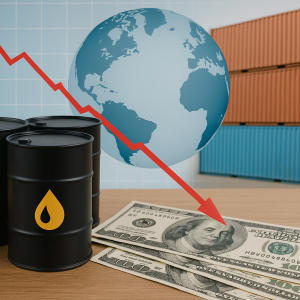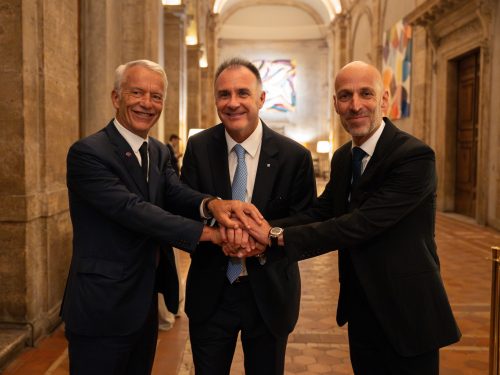Early 2024 with high rates for longer and more expensive oil, but more confidence and expanding services
Saturday 17 February 2024
Share on
Early 2024 in lights and shadows: high rates for longer and more expensive oil, but greater confidence and expanding services. Italy-Eurozone inflation gap wide, timeframe for interest rate cut lengthening. Investments: in the second half of the year, less brake from credit is expected, but now there is an urgent need to accelerate on the NRP. In Italy, for labour the indicators are improving, for consumption so far there are mixed signals. Services are driving, for industry a stop to the decline seems to be approaching, exports are recovering but amid new risks. Stagnation in the Eurozone, in the USA there are signs of braking, while China is expanding.
- Lights and shadows. Italian GDP, which grew at the end of 2023 (+0.2%) thanks to services and construction, is supported in Q1 2024 by rising confidence and inflation just above lows. Industry seems close to ending its downturn, but rates will remain high for longer than expected. There is still a brake on trade flows due to the reduction of transits in the Suez Canal: the waters are calm for the price of gas, albeit high (28 €/mwh in February), while oil is rising (82 $/barrel).
- Inflation: wide Italy-Eurozone gap. Italian inflation rose slightly in January (+0.8% per year, from +0.6%), due to an adverse 'base effect' on energy prices. It also rose in Spain (+3.5% from 3.3%), fell in Germany (+3.1% from 3.8%) and France (+3.4% from 4.1%): in the Eurozone average it fell just to +2.8% from 2.9% in December. The Italy-Eurozone gap is wide, explained by: energy prices falling more in Italy (-21.2%), where they had risen more, than in Europe (-6.3%); core prices of goods and services, which in Italy have already slowed to +2.5%, while in the Area they remain at +3.3%.
- The timeframe for the rate cut is getting longer. The markets' expectations on interest rates remain on the downside, but signal that the slow deceleration of prices could induce a delay: futures had expected the FED and ECB rates to be firm in January (5.50% and 4.50%), but now the first cut is expected in May, no longer in March-April. Sovereign rates were little affected by this: the Italian BTP in February rose to 3.87% (from 3.65%), the Bund to 2.27% (from 2.19), the spread to 161 points (from 146).
- Labour: improving indicators. In December 2023, the employment rate rose to 61.9% (from 59% at the end of 2019), the activity rate to 66.8% (from 65.5%), while unemployment fell to 7.2% (from 9.7%). The expansion of employment lost momentum in November-December, and is now closely linked to the development of economic activity. The recovery in purchasing power of wages, which started in spring 2023, is expected to strengthen in 2024 and will only partly support household consumption.
- Consumption: mixed signals so far. Retail sales declined in December (-0.5%, but +0.1% over 3 months), but household and trade business confidence rose again in January. The financing of consumption by savings is being depleted, but will be replenished by rising real income. Negative judgements on the opportunity to purchase durable goods, due to high rates.
- Services drive. In December, RTT (CSC-TeamSystem) indicated a clear recovery of activity in services (+2.7%) and in January the HCOB PMI confirmed that the sector had returned to growth (51.2 from 49.8). Confidence also continued to rise at the beginning of the year, especially in transport and business services.
- Industry: end of the decline? Production in December partly recovered (+1.1%, after -1.3% in November). In Q4, it is down -0.5% and the large ongoing stock decumulation explains the (fluctuating) increase in turnover reported by RTT. In January, the HCOB PMI rose again (48.5 from 45.3) signalling that the decline is easing, in line with the recovery in business confidence (which remains low) and expectations of stabilising production indicated by companies in the CSC quick survey.
- Exports recover amid new risks. Exports of goods rose in December: +1.3% at constant prices (+1.8% in Q4, -1.8% in 2023), both non-EU and EU. The outlook for early 2024 according to foreign orders improved, in a still weak environment. Tension remains in the Red Sea, which has led to a lengthening of routes (-66% annual volumes for the Strait of Bab el-Mandeb in February, +73% under the Cape of Good Hope) and a leap in freight rates (+170% global freight rates in mid-February compared to the end of November, source: Drewry), which will impact import prices (+5% for a prolonged +100%, OECD estimates).
- Stagnation in the euro area. The Eurozone stagnated in Q4 (GDP +0.03%, after -0.1% in Q3); the trend is barely positive (+0.1% from zero). At the beginning of 2024, there was a slight improvement in confidence (ESI index at 96.2 in January, from 94.9), although well below the levels of early 2022. In contrast, employment expectations continue to decline (EEI at 102.5 from 103.2).
- USA: signs of a slowdown. US industrial production lost ground in January (-0.1%), after having closed 2023 with a modest recovery (+0.3% in November-December but -0.6% in Q4). In manufacturing, the PMI had signalled an improvement at the beginning of the year (at 50.7), while the ISM although rising remains in the recessionary zone (at 49.1). In contrast, residential investment slowed down in Q4: given continuing high rates, demand for housing also seems to have finally cooled.
- China expanding. In China, above-expected growth for 2023 (+5.2%) makes the outlook for 2024 (raised by 4 tenths by the IMF) better. Risks related to weaknesses in the real estate sector remain, but these may not be a drag on growth. Manufacturing has been in an expansionary phase for three months and optimism prevails among entrepreneurs for 2024.
Focus of the month - Investment: urgent need to speed up PNRR
- Investment still weak. The dynamics of fixed investment in Italy basically came to a standstill in 2023 (-0.2% trend in Q3), compared to the brilliant pace of 2021-22. Those in construction fell the most, but the decline extended to machinery and equipment (-0.4% in Q2, -0.9% in Q3). Based on underlying indicators and drivers, their dynamics may improve this year. This is essential for short- and long-term growth.
- Indicators: timid recovery. The signals of the indicators monitoring recent dynamics, which reached their lows towards the end of 2023, paint a picture of stabilising investment, no longer a decline: conditions for investing improved in Q4, although they remained negative (balance at -20.9%, from -31.0%); uncertainty, crucial for companies' spending decisions, decreased in the 3 months to January 2024 (-4.7% the index over the previous 3 months); orders from capital goods companies are just above their lows, with January's recovery; this is reflected in slightly recovering production in the sector at the end of 2023; demand (as measured by manufacturing orders) improved little in early 2024. The latest rosier data for construction investment: the jump in RTT in December indicates a strong recovery, possibly linked to the expiry of the Superbonus at the end of the year.
- Loans: declines easing... For Italian companies, the pressure on bank credit is starting to ease, with the decline in lending easing for the third consecutive month: in December 2023 -3.9% per year (from -6.7% in September). It is worse than in the other major European countries: in Spain the annual decline is slightly smaller (-3.6%), while in Germany (+1.5%) and France (+2.4%) loans are expanding. The lower credit, due to high rates compressing demand and a tightening of supply, thus impacts the competitiveness of Italian manufacturing. Shorter-term data, however, show that the drop in lending in Italy has almost disappeared (-0.3% in December 2023 from September) compared to previous slumps (-4.3% in the same three months of 2022). And credit flows are expected to turn positive again in the second half of 2024, in the wake of the expected reduction in rates.
- ...and high rates but expected to fall. The cost of credit for companies in Italy has increased rapidly since May 2022, when it was at 1.19%, reaching 5.46% in December 2023 (peak at 5.59% in November). This is a higher rate than what companies pay in Germany (5.19%), Spain (5.02%) and France (4.87%). This is weighing on the costs of Italian companies and their competitiveness compared to their EU partners. However, the prospects of an ECB rate cut in the coming months are fuelling expectations of a moderation in the cost of credit and this could facilitate investment in the second half of the year; at the beginning of 2024, on the other hand, this may delay investment decisions just waiting for the cut to materialise.
- PNRR in implementation... So far, almost EUR 41 billion out of 194.4 of RRF resources (21%) have been spent, of which only 13.1 in 2023. Most of the expenditure concerns pre-existing measures and/or tax incentives (Ecobonus, Transition 4.0 tax credits). In 2024-26, expenditure will be at unprecedented and challenging levels, with the risk of not being realised on time: more than 42 billion in 2024 alone. However, an encouraging sign comes from the almost 100 billion in resources already committed by the Plan's implementers.
- ...and well remodelled. The reshaping of the PNRR, which focuses more resources on investments for about 12 out of 14 billion (6.3 for Transition 5.0, 2.5 for green sectors and net zero technologies), is positive. Also positive is the use of automatic tools to speed up spending and the attainability of targets. However, there remains a high degree of uncertainty about the replacement funding sources for measures outside the Plan, which could weaken infrastructure investments. The measure (expected in January) with the necessary measures to roll out the reshaped Plan will be launched in the coming days. Many companies are postponing investments pending the definition of the facilities (Transition 5.0).
- Perspectives 2024. Thus, the first half of the year could see a flat investment dynamic, but thereafter a modest rebound is expected, thanks to improvements in credit and the implementation of the NRP.






















